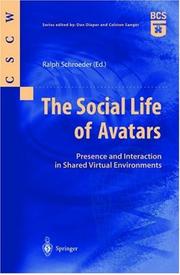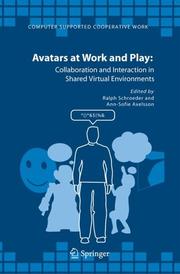| Listing 1 - 10 of 10 |
Sort by
|
Book
Year: 2008 Publisher: Washington : U.S. G.P.O.,
Abstract | Keywords | Export | Availability | Bookmark
 Loading...
Loading...Choose an application
- Reference Manager
- EndNote
- RefWorks (Direct export to RefWorks)
Virtual reality --- Second Life (Game) --- Avatars (Virtual reality) --- Social aspects.

ISBN: 1852334614 Year: 2002 Publisher: London New York Springer
Abstract | Keywords | Export | Availability | Bookmark
 Loading...
Loading...Choose an application
- Reference Manager
- EndNote
- RefWorks (Direct export to RefWorks)
Shared virtual environments --- Avatars (Virtual reality) --- Computer animation
Book
ISBN: 0674972813 067497283X Year: 2017 Publisher: Cambridge, MA : Harvard University Press,
Abstract | Keywords | Export | Availability | Bookmark
 Loading...
Loading...Choose an application
- Reference Manager
- EndNote
- RefWorks (Direct export to RefWorks)
Groping around a familiar room in the dark, relearning to read after a brain injury, navigating a virtual landscape through an avatar: all are expressions of vicariance--when the brain substitutes one process or function for another. Alain Berthoz shows that this capacity allows humans to think creatively in an increasingly complex world.--
Adaptability (Psychology) --- Adjustment (Psychology) --- Mind and reality. --- Brain. --- Identity (Psychology) --- Avatars (Virtual reality)
Book
ISBN: 9781517915407 9781517915391 Year: 2023 Publisher: Minneapolis University of Minnesota Press
Abstract | Keywords | Export | Availability | Bookmark
 Loading...
Loading...Choose an application
- Reference Manager
- EndNote
- RefWorks (Direct export to RefWorks)
"The Switch traces the rise of a technology that has transformed everyday life for billions of people: the binary switch. Chronicling its rapid growth since the mid-nineteenth century, Jason Puskar moves beyond a technical history to offer a cultural and political analysis of how reducing so much human action to binary alternatives has profoundly reshaped modern society"--
Human-computer interaction --- Computer simulation --- Computers --- Avatars (Virtual reality) --- History --- Social aspects

ISBN: 0674055454 067400194X 9780674055452 Year: 1998 Publisher: Cambridge (Mass.): Harvard university press,
Abstract | Keywords | Export | Availability | Bookmark
 Loading...
Loading...Choose an application
- Reference Manager
- EndNote
- RefWorks (Direct export to RefWorks)
Computer. Automation --- Mass communications --- Cyberspace --- Communication and technology --- Written communication --- Cyberspace. --- Avatars (Computer graphics) --- History. --- Avatars (Virtual reality) --- Lerarenopleiding --- (vak)didactiek talen --- Avatars (Virtual reality). --- (vak)didactiek talen. --- Space and time --- Computers --- Telematics --- Technology and communication --- Technology --- Avs (Virtual reality) --- Buddy icons --- Icons, Buddy --- Icons (Computer graphics) --- Virtual reality --- History --- Communication and technology - History. --- Written communication - History. --- Communication en technologie --- Communication ecrite --- Histoire
Book

ISBN: 3839467616 3837667618 9783839467619 Year: 2023 Publisher: Bielefeld : transcript Verlag,
Abstract | Keywords | Export | Availability | Bookmark
 Loading...
Loading...Choose an application
- Reference Manager
- EndNote
- RefWorks (Direct export to RefWorks)
What kind of relationship do we have with artificial beings (avatars, puppets, robots, etc.)? What does it mean to mirror ourselves in them, to perform them or to play trial identity games with them? This volume addresses these questions from artistic and scholarly angles. Contributions on the making of »technical others« and philosophical reflections on artificial alterity are flanked by neuroscientific studies on different ways of perceiving living persons and artificial counterparts. The contributors have achieved a successful artistic-scientific collaboration with extensive visual material.
Avatars (Virtual reality). --- Puppets. --- Robots. --- PHILOSOPHY / General. --- Avatars. --- Film. --- Media Philosophy. --- Media Studies. --- Media Theory. --- Media. --- Neuroscientific Investigations on Perception. --- Philosophy. --- Technological Others. --- Automata --- Automatons --- Robotics --- Manipulators (Mechanism) --- Mecha (Vehicles) --- Puppets and puppet-plays --- Puppet theater --- Avatars (Computer graphics) --- Avs (Virtual reality) --- Buddy icons --- Icons, Buddy --- Icons (Computer graphics) --- Virtual reality --- Avatars (Virtual reality)
Book
ISBN: 3839445795 3837645797 Year: 2022 Publisher: Bielefeld transcript Verlag
Abstract | Keywords | Export | Availability | Bookmark
 Loading...
Loading...Choose an application
- Reference Manager
- EndNote
- RefWorks (Direct export to RefWorks)
What are the characteristic features of avatar-based singleplayer videogames, from Super Mario Bros. to Grand Theft Auto? Rune Klevjer examines this question with a particular focus on issues of fictionality and realism, and their relation to cinema and Virtual Reality. Through close-up analysis and philosophical discussion, Klevjer argues that avatar-based gaming is a distinctive and dominant form of virtual self-embodiment in digital culture. This book is a revised edition of Rune Klevjer's pioneering work from 2007, featuring a new introduction by the author and afterword by Stephan Günzel, Jörg Sternagel, and Dieter Mersch.
Avatars (Virtual reality). --- SOCIAL SCIENCE / Media Studies. --- Avatar. --- Cinema. --- Computer Games. --- Fictionality. --- Media Aesthetics. --- Media Studies. --- Media Theory. --- Media. --- Virtual Reality. --- Avatars (Computer graphics) --- Avs (Virtual reality) --- Buddy icons --- Icons, Buddy --- Icons (Computer graphics) --- Virtual reality

ISBN: 0471988634 Year: 1999 Publisher: Chichester Wiley
Abstract | Keywords | Export | Availability | Bookmark
 Loading...
Loading...Choose an application
- Reference Manager
- EndNote
- RefWorks (Direct export to RefWorks)
Avatars (Virtual reality) --- Interactive multimedia --- Shared virtual environments --- #KVIV:BB --- Hypermedia systems --- Interactive media --- Computer software --- Immersive virtual environments --- IVEs (Immersive virtual environments) --- Multi-user distributed virtual environments --- Multi-user virtual environments --- MUVEs (Multi-user virtual environments) --- Shared VEs (Shared virtual environments) --- SVEs (Shared virtual environments) --- Virtual reality --- Avatars (Computer graphics) --- Avs (Virtual reality) --- Buddy icons --- Icons, Buddy --- Icons (Computer graphics) --- Artificial intelligence. Robotics. Simulation. Graphics
Book
ISBN: 365804909X 3658049103 Year: 2014 Publisher: Wiesbaden : Springer Fachmedien Wiesbaden : Imprint: Springer Vieweg,
Abstract | Keywords | Export | Availability | Bookmark
 Loading...
Loading...Choose an application
- Reference Manager
- EndNote
- RefWorks (Direct export to RefWorks)
Culture plays a crucial role in our lives. Depending on our cultural background, we judge on and react to everything that we encounter. Subtle differences in behavior can lead to misunderstandings or even culture shock. In a similar manner, virtual characters can be declined by certain user groups when showing culturally inappropriate behavior. But how can social aspects such as culture be integrated into the behavioral models of virtual characters? Birgit Endrass addresses this question by carrying out a hybrid approach that is based on theoretical background from the social sciences as well as a multimodal corpus analysis, and exemplified the approach for the German and Japanese cultures. For this purpose, different methods from artificial intelligence and multiagent systems are applied and simulated with a virtual character system. Contents Virtual Agents Behavioral Models Culture: The German and Japanese Cultures Target Groups Academics and practitioners in the fields of Virtual Agents, Autonomous Agents, Human Factors, Multimedia.
Cross-cultural counseling. --- Culture. --- Multiculturalism. --- Avatars (Virtual reality) --- Cultural pluralism --- Engineering & Applied Sciences --- Computer Science --- Psychological aspects --- Cultural pluralism. --- Psychological aspects. --- Cultural diversity --- Diversity, Cultural --- Diversity, Religious --- Ethnic diversity --- Pluralism (Social sciences) --- Pluralism, Cultural --- Religious diversity --- Avatars (Computer graphics) --- Avs (Virtual reality) --- Buddy icons --- Icons, Buddy --- Computer science. --- Artificial intelligence. --- Computer simulation. --- Computer Science. --- Simulation and Modeling. --- Artificial Intelligence (incl. Robotics). --- Culture --- Cultural fusion --- Ethnicity --- Multiculturalism --- Icons (Computer graphics) --- Virtual reality --- Artificial Intelligence. --- AI (Artificial intelligence) --- Artificial thinking --- Electronic brains --- Intellectronics --- Intelligence, Artificial --- Intelligent machines --- Machine intelligence --- Thinking, Artificial --- Bionics --- Cognitive science --- Digital computer simulation --- Electronic data processing --- Logic machines --- Machine theory --- Self-organizing systems --- Simulation methods --- Fifth generation computers --- Neural computers --- Computer modeling --- Computer models --- Modeling, Computer --- Models, Computer --- Simulation, Computer --- Electromechanical analogies --- Mathematical models --- Model-integrated computing

ISBN: 1402038984 1402038836 9048169895 Year: 2006 Volume: v. 34 Publisher: Dordrecht, the Netherlands : Springer,
Abstract | Keywords | Export | Availability | Bookmark
 Loading...
Loading...Choose an application
- Reference Manager
- EndNote
- RefWorks (Direct export to RefWorks)
Avatars at Work and Play brings together contributions from leading social scientists and computer scientists who have conducted research on virtual environments used for collaboration and online gaming. They present a well-rounded and state-of-the-art overview of current applications of multi-user virtual environments, ranging from highly immersive virtual reality systems to internet-based virtual environments on personal computers. The volume is a follow-up to a previous essay collection, ‘The Social Life of Avatars’, which explored general issues in this field. This collection goes further, examining uses of shared virtual environments in practical settings such as scientific collaboration, distributed meetings, building models together, and others. It also covers online gaming in virtual environments, which has attracted hundreds of thousands of users and presents an opportunity for studying a myriad of social issues. Covering both ‘work’ and ‘play’, the volume brings together issues common to the two areas, including: What kind of avatar appearance is suitable for different kinds of interaction? How best to foster collaboration and promote usable shared virtual spaces? What kinds of activities work well in different types of virtual environments and systems?
Shared virtual environments. --- Avatars (Virtual reality) --- Virtual work teams. --- Human-computer interaction. --- Internet games. --- Computer science. --- Special purpose computers. --- User interfaces (Computer systems). --- Computers and civilization. --- Multimedia systems. --- Social sciences. --- Computer Science. --- User Interfaces and Human Computer Interaction. --- Special Purpose and Application-Based Systems. --- Computers and Society. --- Media Design. --- Social Sciences, general. --- Behavioral sciences --- Human sciences --- Sciences, Social --- Social science --- Social studies --- Civilization --- Computer-based multimedia information systems --- Multimedia computing --- Multimedia information systems --- Multimedia knowledge systems --- Information storage and retrieval systems --- Civilization and computers --- Interfaces, User (Computer systems) --- Human-machine systems --- Human-computer interaction --- Special purpose computers --- Computers --- Informatics --- Science --- Electronic games --- Computer-human interaction --- Human factors in computing systems --- Interaction, Human-computer --- Human engineering --- User-centered system design --- User interfaces (Computer systems) --- Eteams (Virtual work teams) --- Virtual teams (Work teams) --- VTeams (Virtual work teams) --- Teams in the workplace --- Avatars (Computer graphics) --- Avs (Virtual reality) --- Buddy icons --- Icons, Buddy --- Icons (Computer graphics) --- Virtual reality --- Immersive virtual environments --- IVEs (Immersive virtual environments) --- Multi-user distributed virtual environments --- Multi-user virtual environments --- MUVEs (Multi-user virtual environments) --- Shared VEs (Shared virtual environments) --- SVEs (Shared virtual environments) --- Software engineering. --- Computer software engineering --- Engineering --- Multimedia systems . --- Video games.
| Listing 1 - 10 of 10 |
Sort by
|

 Search
Search Feedback
Feedback About UniCat
About UniCat  Help
Help News
News